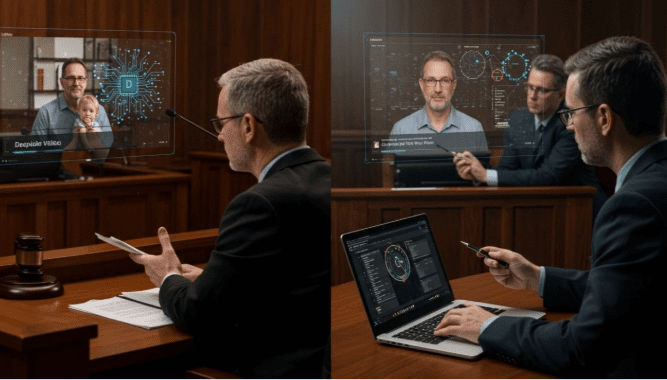Digital evidence is vital to modern legal proceedings, with over 95% of criminal cases now relying on some form of electronic data. Legal professionals and law enforcement face unprecedented challenges as smartphones, laptops, security cameras, and social media platforms create vast amounts of digital footprints. The growing backlog shows more than 25,000 devices awaiting digital forensic examination nationwide.
Device storage capacity has grown exponentially and complicated this situation further. Smartphones in 2013 typically stored 16GB of data (equivalent to about 15 books). Today’s devices can hold 128GB—about 90 meters of bookshelves worth of information. Digital evidence management systems have become essential to handle various types of digital evidence, from data theft and network breaches to online fraud and violent crimes. Best practices in collecting digital evidence have progressed to maintain digital forensic evidence’s integrity throughout investigations and court proceedings. This piece shows how AI tools are transforming contract review and legal research processes and help legal professionals direct their way through the complex digital world of modern law practice.
AI in Legal Operations: Scope and Definitions
AI has become part of legal operations since 2016. A 2024 LexisNexis survey of over 1,200 UK legal professionals reveals that adoption has more than doubled recently. Law firms now set aside money specifically to buy generative AI tools. This marks a big change in how legal professionals do their work. The changes range from simple task automation to complex legal document analysis.
Natural Language Processing (NLP) in Legal Texts
NLP serves as the backbone of many AI-powered legal tools. It lets computers process and extract information from human language. Words are the foundation of our legal system. This makes NLP valuable because it can automatically pull information from unstructured text. Lawyers deal mostly with unstructured documents like judicial opinions, statutes, legal briefs, written agreements, and witness testimony. NLP helps make sense of all this information.
Legal practice uses NLP to process human languages and solve linguistic ambiguity. It combines linguistics, statistics, and computer science to achieve this. To name just one example, NLP-powered systems help law firms search through unstructured text. They can spot key terms in contracts or pull important data from court records in intellectual property cases. These systems save attorneys time by quickly finding specific phrases in long documents. They can also pinpoint exactly where decisions appear in case judgments.
The current NLP models still have major limitations. They can’t easily extract abstract rules from text or build accurate legal ontologies. Even the best language models sometimes make wrong predictions. This happens especially with complex legal scenarios that need a subtle understanding of principles rather than just pattern recognition.
Machine Learning Models for Legal Reasoning
Legal reasoning through machine learning takes several forms. Daniel Katz’s work predicts Supreme Court Justice decisions. Researchers at the Technical University of Munich trained a classifier on 5,990 tax law appeals to predict new tax appeal outcomes. These systems analyze big amounts of legal text to find patterns and relevant information.
Legal reasoning AI has developed in different ways:
- Knowledge-based systems make decisions based on legal precedents and adapt to new interpretations
- Supervised learning models look at previous rulings to predict case outcomes
- Neural networks and deep learning spot complex legal patterns but work like “black boxes” without transparency
Tests show AI tools can be quite accurate. A model for Article 6 of the European Convention on Human Rights matched actual case decisions with 97% accuracy. Another system predicted European Court of Human Rights decisions correctly 79% of the time by analyzing case document patterns.
Rule-based vs Predictive AI Systems
Rule-based and predictive AI systems represent two main approaches to legal automation. Rule-based systems follow preset legal rules to solve standard cases. They work best with well-defined procedures and standard documents like estate planning, real estate deals, and corporate compliance filings.
Predictive justice systems work differently. They look at previous similar cases to forecast possible dispute outcomes. These systems usually use supervised machine learning. Data sets get labeled first, then algorithms learn to predict outcomes and spot patterns. The EU AI Act labels these systems as “high risk” because they can affect judicial decision-making.
Each approach works best in specific legal situations. Rule-based automation brings consistency and reliability to repetitive tasks. It helps reduce human error. Predictive systems offer more flexibility and handle complex scenarios better, especially in litigation support, intellectual property law, and employment law. Notwithstanding that, both types currently work best as tools to help human legal professionals rather than replace them.
Automating Contract Review with AI Tools
AI automation has revolutionized contract review and brought unmatched efficiency to legal teams. AI-powered tools can process thousands of documents at once and deliver results within seconds rather than taking hours or days.
Clause Extraction using Named Entity Recognition (NER)
Named Entity Recognition stands as the foundation of automated contract analysis. This technology acts like a “hawk’s eye” and saves countless review hours. Legal teams can now identify and extract vital information from documents by spotting specific entities such as parties, dates, governing laws, and obligations.
Advanced NER systems detect and classify several elements within contracts:
- Organization names and aliases used throughout the document
- Signing persons and their titles
- Effective dates and termination periods
- Document types and specific clause categories
NER goes beyond simple keyword searches by analyzing meaning, intent, and context within legal concepts. Loan agreements showcase this capability well. Sophisticated NER can spot 11 distinct entity types including amounts, dates, percentages, regulations, and roles. Legal teams can now access key information instantly without reading each page manually.
Risk Scoring Algorithms in Contract AI
Machine learning algorithms have changed how legal teams assess contracts by identifying potential threats. These systems compare documents against predefined risk parameters and match clauses to standard templates or company policies.
Modern risk scoring systems deliver several advantages:
- Quick detection of problematic clauses like non-standard indemnification terms
- Alerts for missing data protection provisions or unfavorable termination conditions
- Spotting of auto-renewal periods that might slip through
- Color-coded risk analysis based on historically challenging sections
Trailblazing AI solutions now suggest smart, context-based revisions for unclear or unfavorable language. Tasks that once took weeks now finish in minutes. Teams can maintain detailed attention to every provision even at high speeds.
Contract Comparison and Version Control Automation
Version control remains the “Achilles’ heel” of traditional contract management and often creates confusion, delays, and potential legal issues. AI solves this by tracking each change, including who made it and when, which creates a secure, transparent history.
AI improves version control through several advanced features:
- Risk flags that spot potentially problematic clause changes between versions
- Smart clause suggestions that recommend standardized language as terms evolve
- Quick summaries highlighting all changes in new versions
AI-powered version control lets users copy specific file versions and modify them for different purposes without changing the original document. Teams save time since the system tracks differences between branched files automatically.
AI has transformed legal operations through automated contract review. Teams now have a shared language between legal and business stakeholders with contract insights in clear formats. The system watches contract portfolios for critical dates, payment terms, and performance obligations throughout agreement lifecycles.
AI-Powered Legal Research Platforms
Modern legal research platforms now utilize artificial intelligence to process big legal information repositories. Attorneys can find relevant cases and precedents with unprecedented efficiency. These technologies are changing how legal professionals conduct research and reduce tasks that once took days to mere minutes.
Semantic Search in Case Law Databases
Traditional keyword-based search systems often restrict legal professionals. They must sift through many irrelevant documents to locate material. Semantic search changes this approach by understanding the context and intent behind search queries rather than matching exact keywords. This technology uses natural language processing, machine learning algorithms, and language semantics to return genuinely relevant results.
Boolean search requires specific syntax (AND, OR, etc.). However, semantic search allows natural language queries, which creates new possibilities when searches aren’t limited by exact text matching. To cite an instance, a search for “employee termination without cause” might surface cases discussing “at-will employment dismissal” even if those precise terms aren’t in the query.
Vector databases are significant in this capability. They store data as high-dimensional vectors (embeddings) that capture semantic relationships between words and phrases. These embeddings represent words or sentences as dense vectors of real numbers in a continuous vector space. The system can calculate mathematical similarity between concepts.
Citation Mapping and Precedent Discovery
Legal citations serve as well-laid-out signals that link legal arguments together and connect current reasoning to previous precedents. Modern AI systems now use these structured formats to automatically parse citations and visualize relationships between cases.
Advanced tools like LegalVis use interactive visual components. They present temporal patterns, enable filtering of relevant documents by topic, and analyze document text to identify potential citations, even when not explicitly specified. This visual analytics approach achieved 96% accuracy in identifying potential citations during evaluation.
Citation mapping tools turn complex analysis into immediate visual clarity through color-coded indicators. These show which precedents have been positively cited, criticized, or overruled. Legal professionals can:
- Instantly assess case authority and strength
- Find hidden connections between cases
- Move directly from overview to specific details using intelligent filtering
AI Summarization of Legal Opinions
Law practice centers on interpreting complex documents—traditionally a tedious and time-consuming process. AI summarization tools now condense volumes of legal text into succinct summaries. They capture essential information while saving significant time.
These tools use large language models and specialized algorithms to examine document content, identify critical information, and generate summaries that capture the essence of original texts. Early adopters report remarkable efficiency gains. 88% of users save up to seven hours per week using AI to summarize case law.
Professional-grade AI summarization solutions generate summaries containing:
- Key legal holdings
- Relevant material facts
- Controlling law
- Court rationale
- Case outcomes
Legal professionals should look for AI research tools offering consistent accuracy, simplified processes, secure handling of sensitive documents, and user-friendly interfaces. These technologies help attorneys focus on higher-value tasks like case analysis and client consultation instead of spending too much time searching for information.
Integration with Legal Workflows and Document Management
AI legal tools work best when they merge with existing document management systems and workflows. This creates an ecosystem where AI tools boost rather than disrupt 2-year old processes.
Connecting AI Tools with Document Management Systems
Document automation revolutionizes how legal teams create and manage documents. Software generates automated templates that eliminate building documents from scratch for each case. Dynamic templates – pre-approved document frameworks adapt based on case-specific details or client needs. These templates link directly to internal systems like CRM platforms, case management systems, or HR databases. This ensures data stays consistent across documents.
AI and document management integration offers several key benefits:
- Templates and custom fields that adapt to specific legal requirements
- Automated workflows and approval capabilities within questionnaires
- Data gathering tools that cut down manual input needs
Legal practice management software comes with document automation features built into existing platforms. This creates smooth solutions for drafting and organizing legal documents. Built-in automation removes platform switching and makes processes run better. Platform compatibility gives a competitive edge – built-in solutions work with case data, while standalone tools need manual data import.
Role of APIs in LegalTech Automation
Application Programming Interfaces (APIs) connect different legal technology systems and help them communicate. An API’s simple function involves code that lets two separate systems interact. It acts as both translator and messenger between platforms. This lets applications use features and data from other applications without building everything from scratch.
APIs help software work together across applications by connecting key parts of a lawyer’s workflow. To name just one example, Contract Express integration with iManage lets users export documents to correct locations automatically. Enterprise search solutions let law firms build unified internal search applications. These deliver relevant information from different data sources at once.
Legal tech providers continue to advance. Organizations should think over API integration to get optimal, automated business processes. APIs must be part of every organization’s roadmap in the digital world. They let newer technologies talk to legacy applications, which offers flexibility when adding new platforms.
Digital Evidence Management System Integration
Digital Evidence Management Systems (DEMS) tackle a growing challenge – most legal evidence now exists in digital form. These platforms offer tools to ingest, search, store, analyze, share, and report on multiple evidence types in one system. DEMS links every agency in public safety and criminal justice. This includes law enforcement, prosecutors, defenders, courts, and corrections.
Modern DEMS platforms make evidence processing easier through several methods. Thames Valley Police’s system allows citizens to upload footage from mobile phones, dash-cams, doorbells, and CCTV straight to their DEMS. This removes the need for disk downloads or officer appointments. The platform handles evidence securely and maintains proper access controls and audit trails.
Digital management software must protect evidence from unauthorized access while giving authorized users easy access. Cloud-based storage offers secure access through protected channels anywhere with internet connection. The best solutions apply analytics and workflow automation throughout the criminal justice process. This breaks down digital evidence silos and removes collaboration barriers.
Accuracy, Bias, and Legal Compliance in AI Tools
AI tools provide remarkable capabilities for legal professionals but face challenges with accuracy, bias, and compliance that need careful review.
False Positives in Clause Detection
The best AI contract review systems can achieve 95% accuracy when identifying key provisions in standard legal agreements. These systems still make mistakes. Legal models generate hallucinations in about 1 in 6 queries. They might cite non-existent cases or misinterpret statutes. The Mata v. Avianca case demonstrated this limitation when a lawyer received sanctions for citing fake cases created by an AI tool.
A landmark test compared AI against experienced lawyers with interesting results. The AI reviewed NDAs with 94% accuracy in 26 seconds. Human lawyers achieved 85% accuracy but needed 92 minutes. These numbers show both the potential and current limitations of the technology.
Bias in Legal Data Training Sets
AI systems learn from unbalanced data and can produce outputs that discriminate based on gender, race, age, or other characteristics. This bias shows up in several ways:
- Data bias: Shows historic inequalities in the legal system
- Development bias: Contains flawed model design
- Interaction bias: Results from how users work with the system
These biases could break ethical rules that require impartiality in legal contexts. Judicial officers must analyze the risks of AI research tools, particularly regarding bias or hallucinations that might break rules against prejudiced actions.
Compliance with GDPR and Legal Ethics
GDPR rules heavily affect AI technologies that process large amounts of data. Users must give explicit consent for personal data usage. Legal professionals who use AI tools should know their limitations and review AI-assisted work carefully. GDPR requires organizations to:
- Process only essential data for the task (data minimization)
- Validate and monitor data accuracy
- Set up proper data protection safeguards
Lawyers must verify all AI outputs before professional use. This human oversight remains crucial because AI should help legal work, not replace legal judgment. A lawyer’s failure to properly assess AI capabilities could result in sanctions under Rule 11 of Federal Rules of Civil Procedure.
Case Studies: AI in Law Firms and In-House Legal Teams
Law firms worldwide now use AI solutions to handle their most crucial tasks. These tools have proven to make their work more accurate and streamlined.
AI Contract Review in M&A Due Diligence
M&A deals usually need thousands of contracts reviewed to check potential risks. AI has reshaped this entire process. CoCounsel Legal analyzes 100 pages in three minutes and completes work that used to take associates several weeks. These AI tools spot essential provisions such as change-of-control clauses and highlight missing papers like notarial deeds or tax declarations. One knowledge management counsel shared, “When I was a junior associate doing M&A contract due diligence, I remember spending so much time in the data room doing manually what CoCounsel can do in minutes”.
Legal Research Automation in Litigation Support
Tools like Westlaw Advantage have reshaped litigation support through AI. These systems scan massive legal databases to find key precedents and learn about cases faster. A partner explained, “I’ll have a summary that’s near perfect and a timeline that outlines every significant event contextually in less than seven minutes. It saves us weeks!”. The numbers show that 77% of legal professionals now use AI to review documents.
Adoption Metrics from Top 100 Law Firms
The numbers keep growing. About 78% of the top 40 UK law firms promote their AI usage, up from 60% last year. The current statistics for top firms show:
- 80% of Am Law 100 use CoCounsel
- 45% of top 20 UK firms have dedicated AI leaders
- 55% provide AI training to their teams, compared to 20% last year
Conclusion
AI has reshaped legal operations through automated contract review and better research capabilities. This piece explores how AI technologies have progressed from simple task automation to sophisticated legal analysis tools. Natural Language Processing lets lawyers pull critical information from document repositories in seconds, not days. Machine learning algorithms spot patterns in case law that humans might miss and provide deeper analysis.
Contract review automation has become revolutionary. Named Entity Recognition technology spots and groups key clauses, while risk scoring algorithms catch potential problems early. Legal teams can now process thousands of documents at once during due diligence, which cuts down time spent on repetitive work. Automated version control tracks every change precisely and removes confusion that could lead to liability.
AI has pushed legal research forward too. Semantic search now understands the context behind questions instead of just matching keywords. Citation mapping shows how cases connect, which helps attorneys quickly check how strong precedents are. AI tools that summarize lengthy legal opinions save professionals up to seven hours each week based on reported numbers.
These tools face big challenges though. AI systems sometimes create false positives or make up non-existent cases, like in the whole ordeal of Mata v. Avianca. There’s another reason to be careful – data bias might reflect historical inequalities in the legal system. Human oversight stays crucial because AI works best as an assistant rather than a replacement for legal judgment.
Usage numbers show growing trust in these technologies. Most top law firms now promote their AI capabilities, and 78% of leading UK firms use AI solutions. This trend will speed up as tools get more sophisticated and work better with existing systems through API connections.
AI tools haven’t replaced lawyers but have made them more capable. The best results come from keeping humans involved while automating routine tasks. Lawyers can focus on strategy and client relationships while AI handles document work. Law firms that embrace these technologies wisely will likely gain competitive edges through better efficiency, lower costs, and improved analytical power.



































